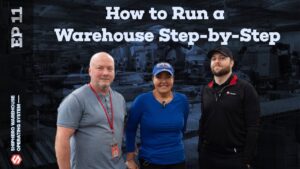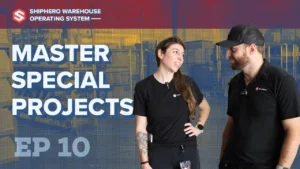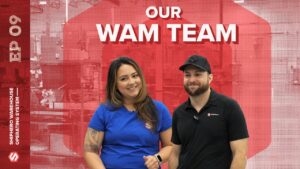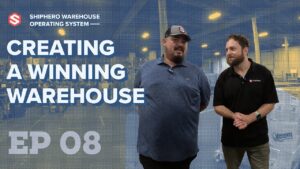Learn how Tyler Anderson, Director of Warehouse Operations at ShipHero SLC, manages his team remotely to ensure efficient warehouse operations.
In this video, Tyler talks about the recent changes in queue management, which consolidates orders into two statuses for better organization. He also shares useful tips on how to solve held orders and optimize inventory management for maximum efficiency. Plus, find out what metrics Tyler suggests tracking with ShipHero’s Hero Board!
Get all the insights you need to stay ahead in the game with Tyler’s advice. Watch now!
Video Transcript
Currently we're working on any of the new
features that roll out with ShipHero to make
sure that they tie into our current processes
and how we can effectively use them on the
floor.
We document that, sign off on it, and then
roll it out to the facilities for training.
I'm here today with Tyler, leading member
of our remote ops team.
Before working on our remote ops team, Tyler
helped run this facility where we are today
in Salt Lake City, Utah.
So first of all, thank you.
No problem.
So we have a bit of a unique setup in that
we have nine buildings and we manage a lot
of what happens in those buildings remotely,
which is what your team does.
So talk us through what is remote ops and...
Well, first of all, why do we do it remotely
instead of having the buildings manage it
all themselves?
So overall, the remote ops team is the ones
that log in,
we manage the queue, manage any orders that
are on hold or possibly have an address issue,
anything along those lines, to basically have
the warehouse focus on getting the orders
shipped out and clearing that queue every
single day.
We shouldn't have any members on the floor
going, logging in, searching for one product,
one SKU, one item or one order, wasting hours
and hours a week just searching for one order.
So the idea is basically it's easier to find
and solve those problems sitting in front
of your computer, and we want our warehouse
managers on the floor, so we keep them on
the floor, and then we have the remote ops
team work remotely from their home computer
basically.
Yeah, absolutely.
Or in in the warehouse in the office.
And that's the biggest part about ShipHero
being spread so across all nine facilities
is we can login remotely, find out the issues,
dig in from anywhere in the country basically.
Right.
Okay.
So we're doing something a bit different called
queue management.
So the way most people use ShipHero is they
put orders in different statuses and then
they have their pickers log into those different
statuses throughout the day and deplete those
orders.
We recently made a change which we call queue
management.
So walk us through first of all why, and then
how does it actually work?
Yeah, so we switched to running the queue
management remotely to avoid pickers scrolling
through dozens of statuses, changing, for
one or two orders getting in one status when
there's 20 in another.
Essentially what we're doing here is combining
everything into the one status and running
it by picking tags.
So we'll add tags to a certain group of orders-
Let's go back.
So the one status is today, right?
Yes.
It's today and tomorrow.
Today and tomorrow status.
That's what we're running.
So if I'm the GM of this building, I have
X number of orders in today.
I got to ship 100% of those orders.
Every one of them has got to go out, and I
don't have to ship anything else.
Right?
Absolutely.
And that is the point of the queue management
being done remote is the remote ops team can
log in and say, "This is how many orders you
have for today.
Move them into those statuses."
So the management team on the floor in the
warehouse doesn't have to worry about looking
through those queues and handling it that
way.
And then once that queue in the today status
hits zero, you're done for the day.
So I think one of the advantages or one of
the problems we would have before is orders
would continue to come in throughout the day,
and sometimes we would end up picking those
orders, and there might be a lingering order
from the prior day that just gets missed in
the shuffle, and we didn't want that to happen.
Yeah, exactly.
Or you have one specific client that does
decent amount of volume over everything else,
and it will just bury the ones and twos orders
that we have in the system.
Yeah, exactly.
Yeah.
So that's another issue we had, which is a
client exceeding forecast dramatically, right?
Absolutely.
3-4X forecast.
And then they're getting the same priority
as another customer who's on forecast, and
then that customer on forecast might miss
SLA, when really we should be hitting our
forecast numbers for everyone, maybe plus
30% forecast, but basically that, and then
save those excess orders for tomorrow for
that client that's over forecast.
So yeah, I'm excited about that change.
So what are the typical problems that you're
solving in the remote team?
So a lot of it is held orders.
An order comes into the system and is a back
order or just needs to be pushed to a specific
facility to ship out.
It's finding those issues before it stops
production on the floor.
Through the queue management side of it, it's
ensuring that each facility has work consistently
throughout the day, so there's no downtime,
and also planning out larger projects like
tearing down the racking like we're doing
in Salt Lake now, and rebuilding some more
pick bins and forecasting out sales volumes
over the peak season for our larger clients.
Right, so you're actually talking maybe with
the CSMs or the account managers, but you're
talking to those clients, getting numbers,
getting plans, and then putting internal plans,
right?
Absolutely.
Okay.
And you guys also work a bit on our SOPs and
process and documenting and making sure we're
uniform across buildings, right?
We do, yep.
Currently we're working on any of the new
features that roll out with ShipHero to make
sure that they tie into our current processes
and how we can effectively use them on the
floor.
We document that, sign off on it and then
roll it out to the facilities for training.
What have you learned as we've developed this
team over the last year that you didn't know
when we started?
A lot, actually.
There's a lot more to logistics and fulfillment
than just putting something in a box and putting
a label on it.
Negotiations with carriers, what you can negotiate,
how to negotiate prices on those.
That was a huge, huge push when I started
with Randall with Golden Egg.
And then a lot of how different seasons affect
different clients, even if it's the same product,
or two clients have the exact same
product, how their sales can drastically differ
even during the same season.
So that was a eyeopener for me as well.
Okay.
Let's look at reporting.
I know you're a big fan of the Hero Board.
Yeah, love the Hero Board.
Explain to me how you used to work without
the Hero Board before that was created and
how you use it today.
Yeah.
So before we had the Hero Board, I would actually
just run a shipments report through Excel
and have a bunch of macros set up of which
picker and packer did how many orders, how
many lines, how many units.
It was very manual data across the board.
Now, with the live shipping board, it's a
couple of clicks and you can find out how
many per hour each person's doing, how many
line items, and then you can take that data
and check it against how many units per order.
If a person's only doing 12 orders an hour,
but they're doing a thousand items, you can
definitely weigh those out quite a bit to
say, "Oh yeah, this is how many we should
be at."
Okay.
And when you bring on a new associate or a
temp, what's the unit picks per hour, the
UPH that you want to see at a minimum, that
you're like, "Hey, I'm going to keep investing
in this associate," versus, "I'm just going
to tell the agency not to send them back"?
Absolutely.
So the first two days we try to hit around
75% of our actual goal, to say that yeah,
this person's good enough to keep on.
The picking system in ShipHero is very easy
to learn and understand.
You can pick it up pretty quick.
The layout of the facility is pretty much
the only thing you need to really pay attention
to on that.
On the pack-out side, we try to hit around
75%, so about 35 to 40 orders an hour is where
we want them to be at the first couple of
days.
Yeah, 'cause we target 50 right?
Yeah.
For a season.
Then what's your consistent best packer?
What number are they hitting?
This last week I believe we were at 75 orders
now for our best packers.
Okay, that's good.
And what makes someone a good packer?
Consistency, actually.
Just keeping that flow going, the consistent
work.
You'll hit those numbers pretty...
The consistent flow of the packer, they'll
definitely hit those numbers pretty efficiently.
What's your favorite feature in ShipHero?
My favorite feature?
It's got to be bulk ship, actually.
All right.
You guys do a lot of bulk here.
We do a lot of bulk ship here, so the fact
that we can...
It automatically lumps everything together
that's similar SKUs, similar carriers.
Everything can be shipped all at one time.
And now we have the QR code scanning for the
picking side, so you don't lose any quality
on your picking side for the bulk ships.
Right.
So that's use the QR code for the puller,
right?
Yep.
And then when you're talking about grouping
it by carrier, I think right now we print
them in order so it's like, let's say, all
the FedEx and then all the UPS, so that you
don't have to second sort, which is a lot
of extra labor.
Yeah, that was a huge help for us.
When we first started out with Golden Egg,
it was...
We'd just print off...
Here's all of our USPS.
Print them all off on one batch, pack them
out, all goes in the same gaylord and goes
straight on the truck.
Yeah, yeah, 'cause the sorting could be half
the work in a quick bulk.
Do we use Auto Baggers here at all?
We previously had one.
I believe we sent ours to Pennsylvania.
They have a lot more smaller items than we
had.
All right.
All right, and now we have none.
You guys are still hitting your numbers, so-
Yeah, we're still cranking it out.
It's been good.
What's the reporting that you do that is maybe
not obvious to a new user of ShipHero?
So honestly, a lot of what I do is tracking
our cost per package internally as well.
And ShipHero has all of that data that you
need for your label costs for every shipment
that we have.
Now with the WorkforceHero, you have your
labor data, you have your hours on each project,
each side, picking, packing.
You can download all of that and run all of
your data to say, "This is where we're actually
at across the board.
Are we in a good spot or not?"
If you were talking to someone who was brought
in, just like you were, to manage a facility
that has some customers but work on process,
where would you tell them to start?
Definitely process is the number one thing.
Make sure you have a solid base foundation
before you start building up on that.
The next side of it, I would say, is your
inventory and your inventory velocities.
So accurate inventory is a huge, huge thing
in this industry.
If you're missing 100 units of something,
that's 100 sales that don't go out the door,
so making sure your receiving is on point,
your inventory is on point and then you're
running your shipment data to slot properly
in your warehouse by velocity.
So you want your fastest movers as close as
you can to your pack stations, slower movers
towards the back a little bit more.
And is that just export, like the shipments
report?
Or how are you knowing what are my fast movers?
So it's based on the shipments report.
It's actually shipping in the system, as well
as the clients also send that over to us as
well, some of them.
Right.
So if we have a forecast, we know there's
a big drop, maybe we put that in our little
highway pallets on the floor, and if we see
something that, hey, this is consistently
selling, we're selling ski goggles because
we're in Utah and it's November, we put that
in the front, not aisle 13.
Exactly.
So you're minimizing that walk for your pickers
from the back of the warehouse to the front.
And then as well as in ShipHero you can set
up your replenishment levels as well per SKU,
and then it will ping our inventory team to
say, "We need more of unit X forward up in
this location as it's moving," so production
doesn't stop because you're just out of inventory
in a pickable bin.
And if people don't realize the value of slotting,
I think the report is 30% of all time is just
spent walking.
And by slotting more correctly, you're reducing
that from 30%, or it could be worse than 30%
if it's a poorly slotted warehouse, down to
a 25%.
And it's just wasted labor.
There's no value for walking further for the
same product, right?
Exactly.
So it's a great way to squeeze more efficiency
without squeezing your employees.
They actually like it better if...
They'd rather be picking in the same amount
of time than walking.
Absolutely.
All right.
Any final tips for a new user of ShipHero?
Learn the system as much as you can.
It's a very robust system, has a lot of features,
so dig in as much as you can and learn everything
you can about it.
All right, Thank you.
Any time.
Appreciate it.



